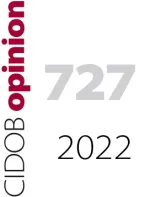Melilla, One More Step

The deaths at the Melilla border fence on 24 June 2022 are one more step, now because of the brutality of the images and the terms of justification afterwards. Building on previous narratives, they claim that traffickers are the real culprits, and migration is a threat to national security. Beyond all the words, what the facts reveal is that, to ensure fewer arrivals, Europe is willing to pay any price.
This article was previously published in the newspaper ARA.
The border violence isn’t new but the deaths at the Melilla border fence on 24 June are one more step. One more step in the images they have left. Although photographs and videos of bodies on the border, and of the violence and illegal acts committed by security forces on both sides have been circulating for some time now, this time they are terrifyingly brutal. The image of heaps of bodies left lying around and treated with contempt has historical connotations that nobody, and least of all in Europe, can ignore.
In addition to the images are the words. The Spanish Prime Minister, Pedro Sánchez, didn’t hesitate to call the immigrants’ attempt to cross the border a “violent attack” against the “territorial integrity of our country”. No mention of the deaths. Moreover, to make matters worse, he congratulated the Moroccan gendarmerie for what he deemed an “assault well dealt with”. Statements like these also represent one more step with the unabashed, categorical assertion that migrations are a question of national defence, as if we were really at war.
But no step is made without others made before it. Two narratives support this new shift. The first is related with Europe’s fixation on traffickers. In the midst of the 2015 refugee crisis and shamed by the images of hundreds of dead bodies at its borders, Europe needed to look for culprits. It therefore singled out traffickers who were then held responsible for the fact that migrants “suffocate in containers, perish in deserts, or drown at sea”. The more inhumane and cruel those on the other side—that of the traffickers—were presented, the more humane and freer from blame the European side of the border appeared to be. In other words, they weren’t our dead but theirs.
The second story is more recent and is linked with the political use being made of migrations. Every time the Turkish (February 2020), the Moroccan (May 2021), or the Belarus (autumn 2021) governments have instrumentalised migration for coercive ends, Europe has winced over the “indecent”, “cynical” use of refugees while, at the same time, being swift to describe the arrival of a few thousand people (families and minors included) as a threat to security, and to declare war in both the tone of its words and in deploying national armies along borders.
This time, in Melilla, there were no traffickers and no government behind the scenes, spurring on the migrants. Anyone with just the slightest knowledge of the reality of the border knows that only those who can’t pay for the help of a smuggler would risk trying to climb these fences that are designed to cause so much harm. This is their last chance when all they have left is their own bodies and the support of the group. Although it’s true that pressure from the Moroccan police pushed them to try to make the jump, this time there was no political objective. On the contrary, the Moroccan government had to demonstrate more than ever before that now, yes, it really was doing its job as guardian of the southern border.
Be that as it may, the Spanish government—and others in Europe—have wanted to keep harping on traffickers and the threat to national security. Such is the performative power of the narratives. Yet it hasn’t realised that its obsession with the border has ended up holding it hostage to conditions imposed by neighbouring countries. The most recent example is its recognition of Moroccan sovereignty in Western Sahara. Even more serious is its now shameless acceptance of systematic violation of basic rights, including even the right to life, and all of this in exchange for fewer arrivals.
This attitude means that there’s no recognition that the narratives of others are equally important. The images of Melilla have appeared around the world, as have those of Ukrainian refugees who have been taken in all over Europe, and those showing the exclusion of citizens of other countries who, also fleeing the war in Ukraine, were denied the same treatment. The African Union has condemned this in both situations. In such a short time, these two facts have helped to prove the point of those who denounce the double standards of a Europe that says one thing and does another.
Finally, there’s the danger of ignoring reality. The migrants will keep arriving and even more so in a world where the numbers of forcibly displaced people keep skyrocketing year after year. Deaths and violence at borders will certainly increase as well. The migrants themselves say it no longer matters when they already have nothing to lose. Meanwhile, Europe will have lost its way, diminished in its own fears, and willing to pay any price.
* This publication has received funding from the European Union’s research and innovation project Horizon 2020, under grant agreement Nº 101004564 (BRIDGES project). The contents of this publication are the sole responsibility of the author(s) and do not necessarily reflect the views of the European Union. The European Commission and the European Research Executive Agency are not responsible for any use that may be made of the information contained in this publication.
Keywords: Melilla, migrations, border, narrative, trafficking, Spain, Europe, security, Morocco, Western Sahara, violence, EU